[English] 日本語
 Yorodumi
Yorodumi- PDB-3vvi: Crystal structure of the coiled-coil domain of the transient rece... -
+ Open data
Open data
- Basic information
Basic information
| Entry | Database: PDB / ID: 3vvi | ||||||
|---|---|---|---|---|---|---|---|
| Title | Crystal structure of the coiled-coil domain of the transient receptor potential channel from Gibberella zeae (TRPGz) | ||||||
 Components Components | Non selective cation channel homologous to TRP channel | ||||||
 Keywords Keywords | TRANSPORT PROTEIN / coiled-coil / regulation of the channel function / ion channel / osomosensor | ||||||
| Function / homology | : / : / : / TRPY1 N-terminal linker helical domain / Calcium channel YVC1-like, C-terminal / membrane / ACETATE ION / Chromosome 2, complete genome Function and homology information Function and homology information | ||||||
| Biological species |  Gibberella zeae PH-1 (fungus) Gibberella zeae PH-1 (fungus) | ||||||
| Method |  X-RAY DIFFRACTION / X-RAY DIFFRACTION /  SYNCHROTRON / SYNCHROTRON /  MAD / Resolution: 1.25 Å MAD / Resolution: 1.25 Å | ||||||
 Authors Authors | Ihara, M. / Yamashita, A. | ||||||
 Citation Citation |  Journal: J.Biol.Chem. / Year: 2013 Journal: J.Biol.Chem. / Year: 2013Title: Molecular bases of multimodal regulation of a fungal transient receptor potential (TRP) channel Authors: Ihara, M. / Hamamoto, S. / Miyanoiri, Y. / Takeda, M. / Kainosho, M. / Yabe, I. / Uozumi, N. / Yamashita, A. | ||||||
| History |
|
- Structure visualization
Structure visualization
| Structure viewer | Molecule:  Molmil Molmil Jmol/JSmol Jmol/JSmol |
|---|
- Downloads & links
Downloads & links
- Download
Download
| PDBx/mmCIF format |  3vvi.cif.gz 3vvi.cif.gz | 88.5 KB | Display |  PDBx/mmCIF format PDBx/mmCIF format |
|---|---|---|---|---|
| PDB format |  pdb3vvi.ent.gz pdb3vvi.ent.gz | 72.3 KB | Display |  PDB format PDB format |
| PDBx/mmJSON format |  3vvi.json.gz 3vvi.json.gz | Tree view |  PDBx/mmJSON format PDBx/mmJSON format | |
| Others |  Other downloads Other downloads |
-Validation report
| Summary document |  3vvi_validation.pdf.gz 3vvi_validation.pdf.gz | 459.1 KB | Display |  wwPDB validaton report wwPDB validaton report |
|---|---|---|---|---|
| Full document |  3vvi_full_validation.pdf.gz 3vvi_full_validation.pdf.gz | 461.9 KB | Display | |
| Data in XML |  3vvi_validation.xml.gz 3vvi_validation.xml.gz | 12.2 KB | Display | |
| Data in CIF |  3vvi_validation.cif.gz 3vvi_validation.cif.gz | 17.9 KB | Display | |
| Arichive directory |  https://data.pdbj.org/pub/pdb/validation_reports/vv/3vvi https://data.pdbj.org/pub/pdb/validation_reports/vv/3vvi ftp://data.pdbj.org/pub/pdb/validation_reports/vv/3vvi ftp://data.pdbj.org/pub/pdb/validation_reports/vv/3vvi | HTTPS FTP |
-Related structure data
| Similar structure data |
|---|
- Links
Links
- Assembly
Assembly
| Deposited unit | 
| ||||||||
|---|---|---|---|---|---|---|---|---|---|
| 1 | 
| ||||||||
| 2 | 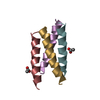
| ||||||||
| Unit cell |
|
- Components
Components
| #1: Protein/peptide | Mass: 2452.955 Da / Num. of mol.: 8 / Fragment: coiled-coil domain, UNP residues 600-620 / Source method: obtained synthetically Details: This sequence is for the coiled-coil domain of the TRP channel from Gibberella zeae Source: (synth.)  Gibberella zeae PH-1 (fungus) / References: UniProt: I1RJZ4 Gibberella zeae PH-1 (fungus) / References: UniProt: I1RJZ4#2: Chemical | #3: Water | ChemComp-HOH / | |
|---|
-Experimental details
-Experiment
| Experiment | Method:  X-RAY DIFFRACTION / Number of used crystals: 1 X-RAY DIFFRACTION / Number of used crystals: 1 |
|---|
- Sample preparation
Sample preparation
| Crystal | Density Matthews: 1.91 Å3/Da / Density % sol: 35.52 % |
|---|---|
| Crystal grow | Temperature: 293 K / Method: vapor diffusion, sitting drop / pH: 8 Details: 18-25% PEG3350, 0.2M sodium acetate, 0.1M HEPES, pH 8.0, VAPOR DIFFUSION, SITTING DROP, temperature 293K |
-Data collection
| Diffraction | Mean temperature: 100 K | ||||||||||||
|---|---|---|---|---|---|---|---|---|---|---|---|---|---|
| Diffraction source | Source:  SYNCHROTRON / Site: SYNCHROTRON / Site:  SPring-8 SPring-8  / Beamline: BL41XU / Wavelength: 0.97909, 0.97944, 0.99159 / Beamline: BL41XU / Wavelength: 0.97909, 0.97944, 0.99159 | ||||||||||||
| Detector | Type: RAYONIX MX225HE / Detector: CCD / Date: May 27, 2010 | ||||||||||||
| Radiation | Monochromator: Rotated-inclined double-crystal monochromator, Si (111) Protocol: MAD / Monochromatic (M) / Laue (L): M / Scattering type: x-ray | ||||||||||||
| Radiation wavelength |
| ||||||||||||
| Reflection | Resolution: 1.25→35 Å / Num. obs: 40607 / % possible obs: 99.8 % / Observed criterion σ(I): -3 / Redundancy: 10.1 % / Rmerge(I) obs: 0.068 / Net I/σ(I): 45.3 | ||||||||||||
| Reflection shell | Resolution: 1.25→1.27 Å / Redundancy: 6.7 % / Rmerge(I) obs: 0.582 / Mean I/σ(I) obs: 3.8 / Num. unique all: 2018 / % possible all: 99.5 |
- Processing
Processing
| Software |
| |||||||||||||||||||||||||||||||||||||||||||||||||||||||||||||||||||||||||||||||||||||||||||||||||||||||||||||||||||||||||||||||||||||||||||||||||||||||||||||||||||||||||||||||||||||||||||||||||||||||||||||||||||||||||||||||||
|---|---|---|---|---|---|---|---|---|---|---|---|---|---|---|---|---|---|---|---|---|---|---|---|---|---|---|---|---|---|---|---|---|---|---|---|---|---|---|---|---|---|---|---|---|---|---|---|---|---|---|---|---|---|---|---|---|---|---|---|---|---|---|---|---|---|---|---|---|---|---|---|---|---|---|---|---|---|---|---|---|---|---|---|---|---|---|---|---|---|---|---|---|---|---|---|---|---|---|---|---|---|---|---|---|---|---|---|---|---|---|---|---|---|---|---|---|---|---|---|---|---|---|---|---|---|---|---|---|---|---|---|---|---|---|---|---|---|---|---|---|---|---|---|---|---|---|---|---|---|---|---|---|---|---|---|---|---|---|---|---|---|---|---|---|---|---|---|---|---|---|---|---|---|---|---|---|---|---|---|---|---|---|---|---|---|---|---|---|---|---|---|---|---|---|---|---|---|---|---|---|---|---|---|---|---|---|---|---|---|---|---|---|---|---|---|---|---|---|---|---|---|---|---|---|---|---|
| Refinement | Method to determine structure:  MAD / Resolution: 1.25→24.95 Å / Cor.coef. Fo:Fc: 0.976 / Cor.coef. Fo:Fc free: 0.958 / SU B: 1.678 / SU ML: 0.036 / Cross valid method: THROUGHOUT / σ(F): 0 / ESU R: 0.051 / ESU R Free: 0.055 / Stereochemistry target values: Engh & Huber MAD / Resolution: 1.25→24.95 Å / Cor.coef. Fo:Fc: 0.976 / Cor.coef. Fo:Fc free: 0.958 / SU B: 1.678 / SU ML: 0.036 / Cross valid method: THROUGHOUT / σ(F): 0 / ESU R: 0.051 / ESU R Free: 0.055 / Stereochemistry target values: Engh & Huber
| |||||||||||||||||||||||||||||||||||||||||||||||||||||||||||||||||||||||||||||||||||||||||||||||||||||||||||||||||||||||||||||||||||||||||||||||||||||||||||||||||||||||||||||||||||||||||||||||||||||||||||||||||||||||||||||||||
| Solvent computation | Ion probe radii: 0.4 Å / Shrinkage radii: 0.4 Å / VDW probe radii: 0.6 Å / Solvent model: BABINET MODEL WITH MASK | |||||||||||||||||||||||||||||||||||||||||||||||||||||||||||||||||||||||||||||||||||||||||||||||||||||||||||||||||||||||||||||||||||||||||||||||||||||||||||||||||||||||||||||||||||||||||||||||||||||||||||||||||||||||||||||||||
| Displacement parameters | Biso mean: 19.17 Å2
| |||||||||||||||||||||||||||||||||||||||||||||||||||||||||||||||||||||||||||||||||||||||||||||||||||||||||||||||||||||||||||||||||||||||||||||||||||||||||||||||||||||||||||||||||||||||||||||||||||||||||||||||||||||||||||||||||
| Refinement step | Cycle: LAST / Resolution: 1.25→24.95 Å
| |||||||||||||||||||||||||||||||||||||||||||||||||||||||||||||||||||||||||||||||||||||||||||||||||||||||||||||||||||||||||||||||||||||||||||||||||||||||||||||||||||||||||||||||||||||||||||||||||||||||||||||||||||||||||||||||||
| Refine LS restraints |
| |||||||||||||||||||||||||||||||||||||||||||||||||||||||||||||||||||||||||||||||||||||||||||||||||||||||||||||||||||||||||||||||||||||||||||||||||||||||||||||||||||||||||||||||||||||||||||||||||||||||||||||||||||||||||||||||||
| LS refinement shell | Resolution: 1.248→1.28 Å / Total num. of bins used: 20
| |||||||||||||||||||||||||||||||||||||||||||||||||||||||||||||||||||||||||||||||||||||||||||||||||||||||||||||||||||||||||||||||||||||||||||||||||||||||||||||||||||||||||||||||||||||||||||||||||||||||||||||||||||||||||||||||||
| Refinement TLS params. | Method: refined / Refine-ID: X-RAY DIFFRACTION
| |||||||||||||||||||||||||||||||||||||||||||||||||||||||||||||||||||||||||||||||||||||||||||||||||||||||||||||||||||||||||||||||||||||||||||||||||||||||||||||||||||||||||||||||||||||||||||||||||||||||||||||||||||||||||||||||||
| Refinement TLS group |
|
 Movie
Movie Controller
Controller





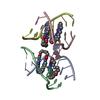
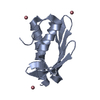


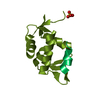
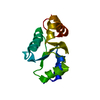
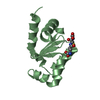
 PDBj
PDBj


